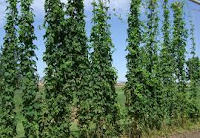Beer 101: The Hops
 |
| Hops growing |
 |
| Hops just before harvest |
While most people have enjoyed a beer or two in their lives, there is still some mystery as to the various ingredients in beer and how exactly they make up the different flavors. Some seem fairly straight forward, a hoppy beer, one can deduce, uses a larger quantity of hops to achieve its flavor. Though darker beers, or chocolaty beers, or some of the dry Belgian style of beer have characteristics which might not be as obvious to someone who hasn't spent a good deal of time learning about beer. I thought that maybe a little beer education 101 was in ordering and that over a few posts we'd look at some of the various ingredients of beer and take a look at exactly how they influence the shaping of the final product. First up, the hops!
I'd like to start with hops because not only are they a key component of many styles of beer, but they are also a part of New York State history. Right up until the start of the 1900's there was a thriving hop farming business throughout many parts of upstate New York (with the largest growing area being Madison county). European settlers brought hop plants with them and found the region to have a climate that was conducive to the growing of the hop vines. Since beer was a large part of both European history and culture, it seemed only natural that they should bring their brewing ways, and ingredients with them to the New World. While farmers did have to deal with a blight in the soil that damaged large portions of some hop crops it was the US government that destroyed the fledgling hop industry in New York. Prior to the enactment of Prohibition New York grew upwards of 90% of the hops used in making beer in the country. Since outside of brewing the hop plant had limited applications many farmers switched their fields to other crops in order to continue earning a living. A lot of the hop growing moved out West, primarily to Oregon and Washington and after the repeal of Prohibition that area took off as the new hop growing region for the country. While taking trips through New York back roads one can still find wild hops growing where once they flourished as a cash crop.
But what exactly is a hop? The hop is the flowering part of the humulus lupulus plant, a vine like perennial. The flowering portion, sometimes called a seed cone, is a green cone like flower that produces a sticky yellow substance known as lupulin oil. It was discovered early on that hops help in the stabilization of beers, allowing them to be transported and stored for longer periods of time without spoilage. While there is still speculation about when and where hops were first used in beer making, it was the English who most famously used them to allow the long transport of their beer by ship to their colony in India, hence the formation of the style known as India Pale Ale.
The oils in hops can contribute both to the bittering quality of the beer, as well as many different flavors and aromas. As such hop types generally break down in to two categories, bittering hops and aroma/flavoring hops. The hops added during the initial portion of the boil are used for bittering. During the long boil of the beer the essential oils in the hops break down creating a bittering flavor in the beer. Most beers, even those with very low to no perceptible bitterness will contain some amount of bittering hops. Our Cayuga Cream ale uses the bitterness from the hop to take edge of the sweetness of the malt and lend to it's crisp, relaxed finish. Aroma hops are added towards the very end of the boil. While you want to draw the oils out of the hop and in to the beer, you want to minimize how much of that oil gets broken down as it is the oils that contribute both flavors and aromas to the beer. These characteristics can range from very floral or herbal characteristics to having very earthy overtones. Some of the more popular North American hop varieties are known for their citrusy or tropical fruit like flavors and aromas.
 |
| Hop harvest drying |
There have been many studies showing potential medicinal properties of hops, and in fact have been used for centuries for a range of medicinal applications such as anti-inflammatory or as an analgesic. There are even studies showing the use of hops in moderation can reduce the chance of prostate cancer. While none of these studies are conclusive they all lend to the mystique and wonder of the hop. Though for us, it's most celebrated quality is how it helps to make our Rogues' Harbor Brewing Company's beer taste so wonderful!


